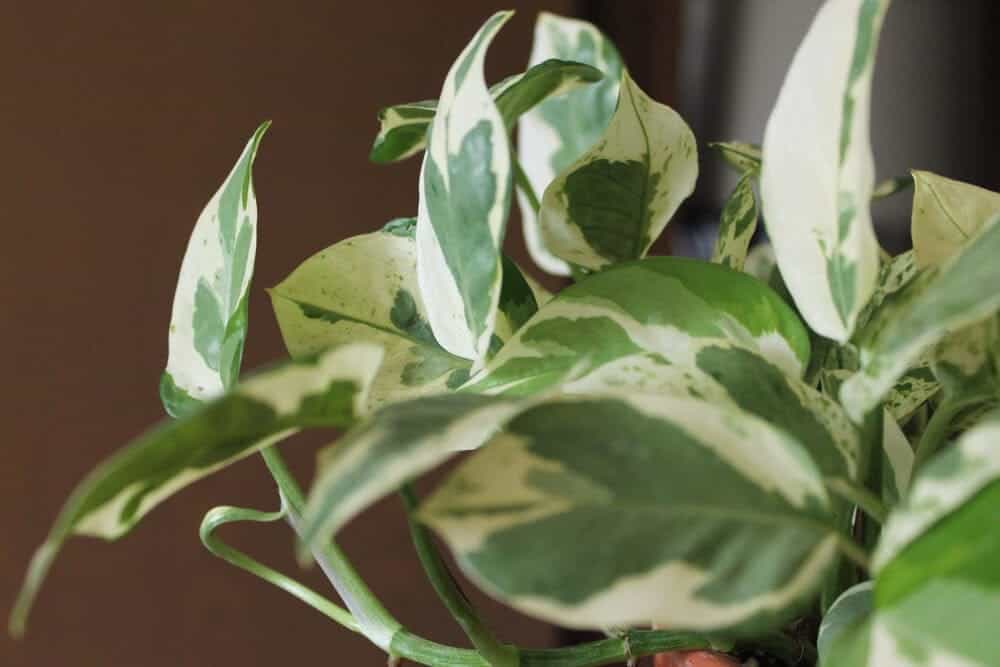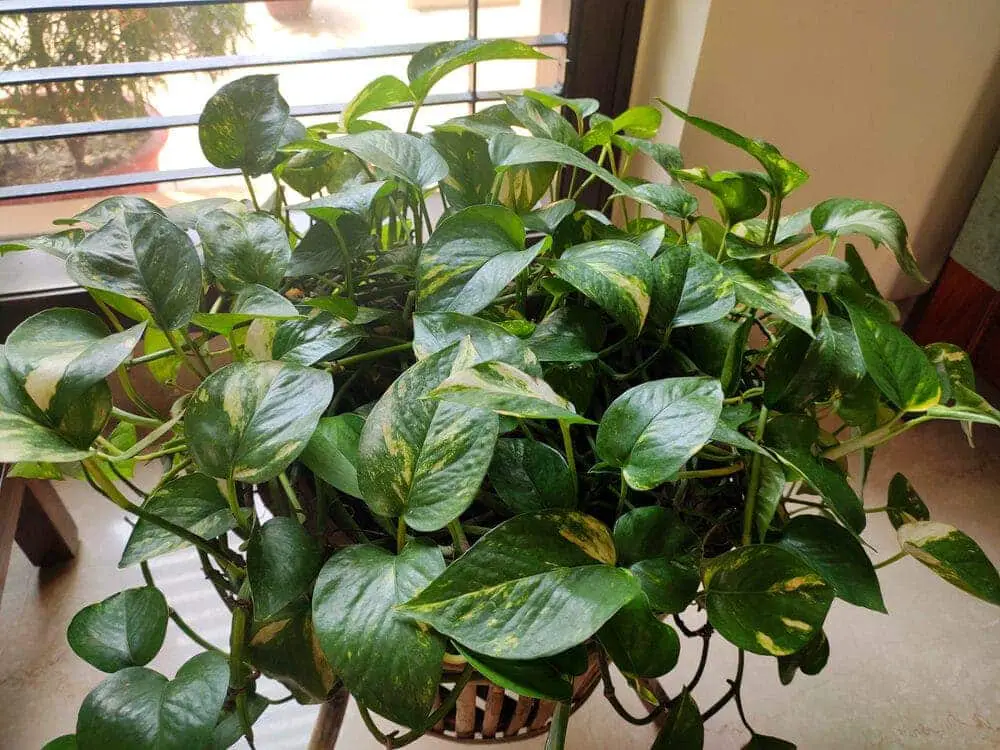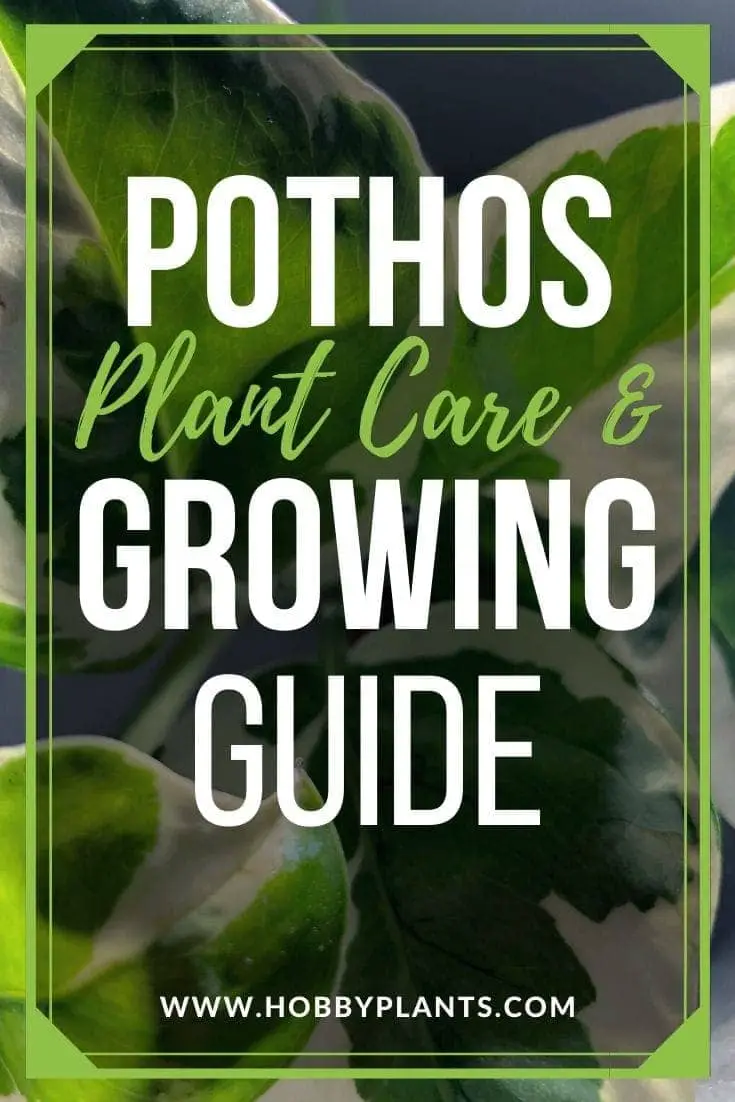If you want to grow a nice looking houseplant without much effort, the pothos plant is a great choice.
These plants don’t require a great deal of maintenance or upkeep, so they are perfect for those with a busy schedule.
In this article, you’ll learn how to care for this plant effectively.
Pothos Plant Care & Growing Guide
1. Light Requirement
The pothos plant can thrive in shady or partially shady areas. This plant does best when placed in indirect light when kept inside. If the leaves on your plant appear pale, it probably means that they are getting excess sun exposure. If the leaves turn completely green with no pattern variation, you’ll want to provide the plant with more light.
2. Water
You need to make sure that the soil your plant is in gets bone dry before watering it again. Constant exposure to wet soil can lead to root rot with these plants, so you need to keep that in mind.
The first sign of root rot is black areas on the leaves; this means that the soil is being kept too damp. You will know when this plant needs water, as it will begin drooping. You don’t want to let the leaves droop too much though, as the damage might become irreversible.
If any of the leaves on your pothos plant have started becoming brown around the edges, you have gone far too long without watering it.
3. Climate
Pathos plants tend to grow in temperate and tropical climates. While these plants can easily survive in hot tropical regions, they do need at least a little bit of shade to thrive. If you visit Florida, you are likely to see these plants at some point, and they grow fairly large.
4. Soil
One of the best things about growing and caring for the pothos plant is that it doesn’t require any special soil. You can use regular old potting soil, provided that it drains well without any issues. Make sure that the soil has a semi-high acidity level or pH for the best growing results.

5. Temperature
These plants need to be kept at above 50 degrees Fahrenheit at all times. The ideal temperature range for pothos is 65 to 75 degrees Fahrenheit. The fact is that these plants don’t do well when exposed to very high or low temperatures. They thrive in areas with lots of humidity but can survive in low-humidity conditions.
6. Repotting
Once the roots begin filling up the container that your pothos plant is currently in, you will need to repot it. If you notice the leaves drooping despite watering it properly, you’ll want to lift up the entire plant. This should tell you whether or not repotting is necessary.
When you are ready to repot your pothos, you will need to put it in a pot that is one to two times larger. Make sure that the new container has fresh soil that is exactly the same as the kind it is in right now.
7. Speed of Growth
There is no question that the pothos plant can grow very quickly, especially when it is grown under ideal conditions. You will need to be ready for a very fast rate of growth in order to properly care for it.
8. Height and Spread
The pothos plant can grow up to 40 feet tall with a spread of three to six feet under the best growing conditions. You will therefore need to make sure that you have enough space for it, wherever you put it.
9. Flowers
The flowers of the pothos plant are not visually stunning like some other plants. The flowers of this plant tend to be green or off-white color. There are certain species of this plant that have larger flowers than others. It is not common for pothos plants in the wild to have visible flowers.
10. Trimming
You will want to keep the stems of this plant fairly short so that the foliage is plentiful along the stems. If the stems of the plant do not bear any foliage, you can always cut them down to the soil level and they will grow back.

Is the Pothos Plant Poisonous?
The last thing you want to do is to ingest any amount of a pothos plant, as it is considered poisonous. These plants rarely result in the death of humans, but they are very dangerous for house pets like cats or dogs to ingest.
Can Pothos Plants grow in Water?
You can grow a pothos plant in water, provided you give it the necessary nutrients. You will be able to grow one of these plants in a regular vase without much effort.
How to get Pothos Plants to Flower
Pothos plants typically begin to flower when they get up to 35 feet large. If you want your plant to flower, you’ll have to put it in the ground. While it is impossible to encourage flower growth in these plants, this is your best shot.
Common Pothos Plant Diseases
Pothos plants are prone to a couple of different diseases, including:
- Pythium Root Rot: Root rot typically occurs when the soil the plant is in is kept too damp. The most common sign of this is yellowish leaves.
- Bacterial Leaf Spot: This particular disease presents as yellow halo marks on the leaves, and it can spread very fast.
Conclusion
- Pothos plants are very easy to grow and maintain, making them great for beginners.
- If you keep one of these plants inside, it should be kept in an area that receives indirect light.
- You can always tell that your plant needs water when it begins to droop.
- You should wait until the plant’s soil is completely dry before giving it another drink of water.
- The ideal temperature range for these plants if 65 to 75 degrees.
- It is fairly common for pothos plants to thrive in tropical climates, such as Florida.
- These plants grow very quickly under ideal conditions, so you need to be prepared for that.
- A pothos plant can grow up to 40 feet tall and six feet wide.
- Remember that pothos plants are poisonous, especially to small children and pets.
- You can grow one of these plants in water with a vase and the right nutrients.

Victoria is the owner and main author of hobby plants. She loves spending her free time in her garden planting and taking care of her plants. Victoria hopes you enjoy the content here!
![How Often Should You Water Pothos? [Complete Care Guide] How Often Should You Water Pothos? [Complete Care Guide]](https://www.hobbyplants.com/wp-content/uploads/2022/07/how-often-to-water-pothos-300x158.jpg)
![How To Propagate Pothos? [COMPLETE BEGINNER'S GUIDE] How To Propagate Pothos? [COMPLETE BEGINNER'S GUIDE]](https://www.hobbyplants.com/wp-content/uploads/2022/07/how-to-propagate-pothos-300x158.jpg)
![Mother Of Thousands Plant [Complete Plant Care Guide] Mother Of Thousands Plant [Complete Plant Care Guide]](https://www.hobbyplants.com/wp-content/uploads/2022/07/mother-of-thousands-plant-300x158.jpg)
![Majesty Palm Plant Care: [Complete Beginner's Guide] Majesty Palm Plant Care: [Complete Beginner's Guide]](https://www.hobbyplants.com/wp-content/uploads/2022/08/majesty-palm-care-300x158.jpg)
![Exotic Angel Plant Care: [Complete Beginner's Guide] Exotic Angel Plant Care: [Complete Beginner's Guide]](https://www.hobbyplants.com/wp-content/uploads/2022/08/exotic-angel-plant-care-300x158.jpg)
![Snow White Waffle Plant: [Complete Care Guide] Snow White Waffle Plant: [Complete Care Guide]](https://www.hobbyplants.com/wp-content/uploads/2022/08/snow-white-waffle-plant-300x158.jpg)
![Waffle Plant Care: [Complete Beginner's Guide] Waffle Plant Care: [Complete Beginner's Guide]](https://www.hobbyplants.com/wp-content/uploads/2022/08/waffle-plant-300x158.jpg)
![Bird Of Paradise Plant Care: [Complete Beginner's Guide] Bird Of Paradise Plant Care: [Complete Beginner's Guide]](https://www.hobbyplants.com/wp-content/uploads/2022/08/bird-of-paradise-plant-300x158.jpg)
![Purple Passion Plant Care: [Complete Beginner's Guide] Purple Passion Plant Care: [Complete Beginner's Guide]](https://www.hobbyplants.com/wp-content/uploads/2022/08/purple-passion-plant-care-300x158.jpg)
![China Doll Plant Care: [Complete Beginner's Guide] China Doll Plant Care: [Complete Beginner's Guide]](https://www.hobbyplants.com/wp-content/uploads/2022/09/china-doll-plant-care-300x158.jpg)
![Polka Dot Plant Care: [Complete Beginner's Guide] Polka Dot Plant Care: [Complete Beginner's Guide]](https://www.hobbyplants.com/wp-content/uploads/2022/09/polka-dot-plant-300x158.jpg)
![Mona Lisa Lipstick Plant Care: [Complete Beginner's Guide] Mona Lisa Lipstick Plant Care: [Complete Beginner's Guide]](https://www.hobbyplants.com/wp-content/uploads/2022/09/lipstick-plant-mona-lisa-300x158.jpg)